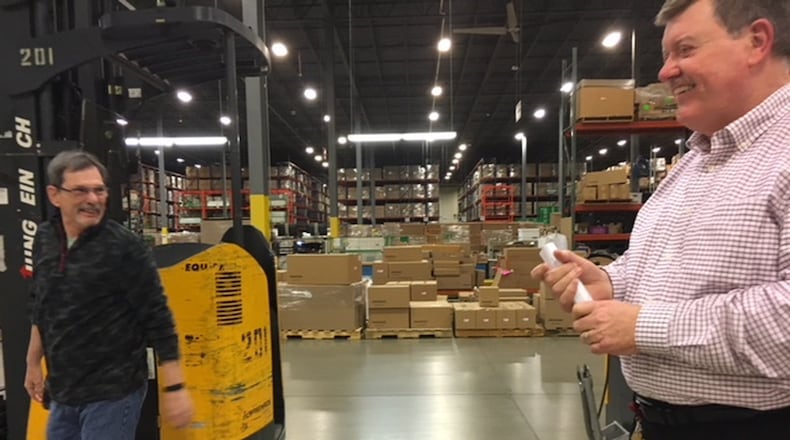But a crucial part of what keeps Honda running is in Troy. Two sprawling buildings off Commerce Center Boulevard keep more than 1,300 U.S. Honda and Acura dealers supplied with the parts they need to do business.
The two Troy facilities — a 534,000-square-foot parts distribution center and an $89 million, 549,000-square-foot distribution hub, called the Midwest Consolidation Center — help feed a national network of sister parts centers and hubs.
There are two distinct buildings at work in Troy with different tasks. The Midwest Consolidation Center, built in 2007 — also known as the “MCC” — is on about 60 acres adjacent to the older parts center. The parts distribution work actually started on Poe Avenue in Dayton before moving to Troy in the late 1980s.
FROM MARCH: Beavercreek weighs Soin expansion plan
‘It’s not just cars’
To oversimplify a bit, the trio of hubs feed nine parts centers across the country, which then ship parts out to Honda’s 1,300 U.S. automobile dealers and other dealers globally, said James Dromey Jr., senior manager, procurement and logistics for American Honda Motor Co. Inc.
American Honda Motor Co. has about 600 employees in the pair of Troy buildings off Interstate 75. The site is less than an hour away from the Anna engine plant to the north, and a longer driver from the Marysville assembly plant — but the Troy sites don’t immediately serve assembly work.
“Assembly plants build the cars, customers buy the cars,” said Greg Propes, senior manager, Parts and Service Division, for American Honda Motor. “When the customers needs service and repair, we’re the end product.”
MORE: What's next for Hara Arena's future?
A dizzying array of parts are shipped to and from these sites. If someone needs a Honda lawnmower engine, that can be found somewhere in the sprawling plants.
“It’s not just cars,” Propes said. “We do motorcycle parts, we do power equipment parts, jet skis — just about anything we have built.”
Anything a customer brings in for repair or maintenance, they can get parts from Troy or sister facilities elsewhere. Wheels, batteries, motor oil, sheet metal — the national network tracks about 485,000 unique “SKUs” or different active parts numbers.
“We carry service parts for any Honda in the last 20 years,” Propes said. “A lot of OEMs (original equipment manufacturers) do 10 or 15 years, and after that, you’re at the mercy of however you can get the part.”
But Honda products tend to last a long time, he said. “Twenty years is our minimum,” Propes said.
Parts will be set aside for the new Acura NSX “super car” for 35 years, he added.
HARA UPDATE: ‘Very large’ users are eyeing arena property
“We definitely want Honda genuine parts on the car,” Dromey said.
One of the Troy buildings, the service parts center, opened a little more than a decade ago, poised to serve what at the time were record auto sales domestically.
“The more units in operation that are out there, the better off that we are,” Dromey said.
Then the Great Recession hit. But the operations never laid off any workers.
“It can be a crunch sometimes when things aren’t flowing in,” Dromey said.
But the sites are "always hiring," he adds. (A Honda spokesman advised applicants to go to https://www.honda.com/careers.)
Honda has some 1,200 suppliers nationally, with more than 170 in Ohio. Parts go from suppliers to hubs, which either package the parts or ship them to the nine parts centers.
The Troy hub will satisfy all nine Honda parts centers nationally. Up to 270 freighter-loads of components arrive at the Troy hub daily, before being deployed to the parts centers, Propes said
RELATED: Downtown Dayton's 4th largest building sold, will be renovated
“What we don’t need to deploy out, we store in this building (the Troy hub) as a reserve, and then deploy it out later on as needed,” he said.
Troy serves not just U.S. dealers. What’s here can be to sent to Japan, Brazil, China and elsewhere.
As always, location matters when it comes to distribution. Asked why American Honda Troy, Propes says simply: “Logistics to the dealers and logistics to the suppliers.”
“The location here — it’s fantastic for getting around the country,” he said.
“The 75/70 corridor is great for us,” Dromey said. “We try to get in a center of a zone, if possible.”
About the Author

